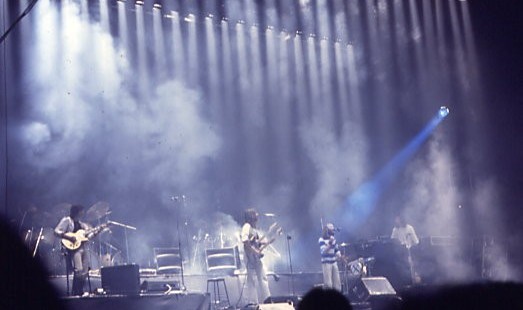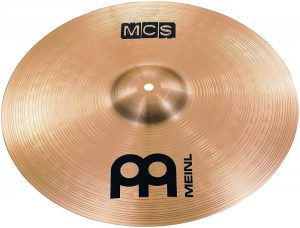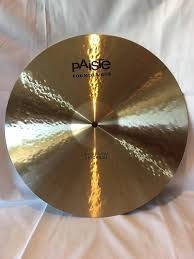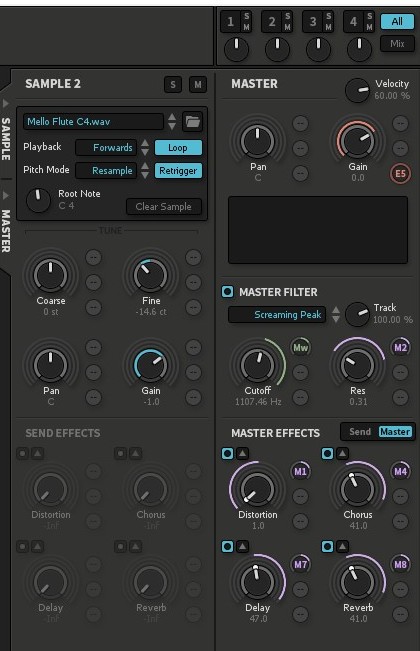
On a swaying brown branch in northern Madagascar, in the dry, gritty wind of a baking afternoon, a Parsons Chameleon sits amazingly still.
He’s blending. Blending in perfectly with the sparse foliage and branchery around it, and waiting…
Waiting for that tantalizing treat that always comes with patience – his baited, buzzing bug snack!!
The reason he’s so good at snagging these juicy gems is because of its singular, creative trait – the ability to blend in with its surroundings by changing its hues and tones to whatever it wants.
(Sigh) Man… if only we could do that with our guitar rigs.
Oh. Wait…
WE CAN!!!
Friends & Lizards
One of the great things about hosting a website about music gear is that your wacky musician friends are more than happy to share and talk about their latest G.A.S. attacks and why their choice is so legit. “Dude – you won’t believe this thing! The sound is AMAZING!!”
Been there, played that! It’s a rare instrument which has a sound so intoxicating that it stands out from the pack, but when you hear it… you WANT it. Bad!
Enter the ever lick-ready John Fiaschetti, one of my good friends who loves to shred. He was quite rambunctious for the chance to show off his latest gear acquisition – the Line 6 Helix guitar processor. So we obliged him the opportunity by shooting a video of his G.A.S.relief celebration. If you haven’t seen this video, treat yourself and check it out HERE.
A Tone-Changing Beast!
Now that you’ve heard and seen John’s personal paean to this new product, let’s explore some specifics that led him to take the plunge and ascend the stairway to guitar-modeling heaven.
Line 6 has been at the modeling game for over a couple decades now, first appearing in 1996 by releasing a small combo amp called the “Flextone”. In the mid 2000s I used their Bass Pod for some live and studio use. They had a dream of really making digital modeling a force to be reckoned with that could emulate real amps and mics and such authentically.
They did a good job too. In the 90s and 2000s though, I still didn’t think they nailed the sound of real amps, because my real amps always sounded better to me in the mix. But they came close enough for rock ‘n’ roll and, with the advent of their “Pod” series, they took over a large share of the guitar gear market, a big reason being their very low, approachable pricing.
Fast forward to June 2015, when their new “Helix” was unveiled. Immediately we all could tell this was a big step forward from where they’d been. The patches actually could fool you into thinking the real amp was being used. Who’da thunk?!

You can dial in whatever tone you’re dreaming of on the Helix. The raw materials within this unit are vast, and stellar. The picture above shows you just how many different pieces of gear are emulated superbly in the Helix.
The plethora of options might be excessive for some, but for myself personally, I appreciate having options when trying to get that perfect mix for whatever the latest song is that I’m working on. With this many variations in the Helix, it’s actually easy to find the ways to craft the tone you’re after, and with a few knob adjustments… or maybe even right outta the box!
The amp models, the mic models and the effects are truly robust and endlessly configurable. You could spend the rest of your life playing with them and creating untold trunks, branches and boughs of cool sounds to grow your tonal forest.
Want to emulate the exact tone of a Mesa Boogie Mark IV on its Channel 1, with an SM57 mic pointed off axis from the cone from 6 inches away? No problem.

Of course, it’s not going to actually say “Mesa Boogie Mark IV”, because that’s a trademarked name. Lucky for you and all of us though, the manual provides a heartening “translation page” that will tell you that the “Cali IV Rhythm 1” patch is exactly that amp and channel. Nice!
The same is true for Effects, Speakers and Microphones; whatever combinations you want to use, you can dial it in and set your sound free, quick and easy.
Because of this, if you’re a musician who has to emulate a lot of different tones and approaches in your work, like session players or wedding bands, this is a welcome aid to keep you playing more than you’ll have to edit. That’s always a plus.
The basic elements of each sound you create or call up are put together with “blocks”. These are the amps, cabs, effects, splits, loopers, inputs, outputs, and impulse responses.
Then you can set the “paths”. This sets the signal flow, which can be parallel or serial, and the Helix allows you two completely separate pathways to really configure some wild variations if your blood runs that cold.
Need to have rigs set up for different concerts? The Helix provides you with 8 setlists, which can hold up to 128 presets. Unless you’re Superwoman, that’s waaaaay more than you’ll need for any live event. Good to have the wiggle room though, right?
Your requisite sends and returns are available, as well as the possibility to set it up in stereo mode.
Reptilian Easy Street

One thing that is very consistent about the Helix line, that I’m hearing from amateurs, gigging friends, and all the way up to pros and audio mags that I have trusted for decades, is the level of ease with which you can perform functions.
The Line 6 team has really thought out the editing hierarchies well, and pretty all are in agreement – if you need to make any changes to your tone you can do so quickly with simple controls that make access and on-the-fly mods a Madagascar breeze. It’s not just that the raw materials are there to mix, it’s that they are also easy to mix.
The unit comes with a full color ‘cheat sheet’ that will make it easy for you to edit whenever you need to without consulting the full manual. That’s cool. I remember they did the same thing for the Bass Pod, back in the day, and I used that sheet all the time!
Currently I see on the Line 6 website you can also register, once you’ve purchased the Helix, for a second full year of warranty coverage… for free! Can’t remember ever seeing that happen before for any piece of gear I’ve purchased, so if you’re at all interested, this is a great time to buy so that you get double the protection over this valuable processor.
Can You Spot an Imposter??
The biggest hurdle regarding Line 6 products is simply this: do emulations hold up as well as the real things for you? In other words, can you play through a modeling product and come out with a sound that is as hot, beefy, toned and appropriate for your genre and song lists as what you get through your rig of outboard gear?
From my research, most are saying they can with the Helix. That’s why this thing is getting 5 stars all over the place in personal reviews.

I can tell you this also: many times, those that hold the line against emulations, and loquaciously issue tirades against the chameleons of the jungle, are spouting off from their own egos without any actual testing behind it.
I’ve worked in the pro audio niche for decades now, and I have personally witnessed people who said they could tell the difference between an outboard gear piece and the equivalent software product go down in flames when various companies would actually set up for us an A/B comparison to test our ears and sound recognition abilities. Especially with this new iteration of pro modeling coding, it’s going to be quite the rare person that will be able to tell the difference.
Despite that, there are some online to write that they can hear the difference. Well, if you can, then just keep walkin’. Gear modeling is not for you.
But for the rest of us, we have no problem shredding solos for the fans and sounding convincing enough for the masses cheering with their hands in the air with the Helix. To my ears, John’s ears, and hundreds of others, it delivers the goods as handily as a chameleon tongue delivers lunch!
Made in the Jungle Jam Shade!
The Line 6 Helix could very well be the dream rig of hundreds, if not thousands, of gigging musicians who want the flexibility and quality of sound it provides, but can’t afford the other similar offerings from other modeling companies like the Axe FX or the Kemper Rack. I’ve also found online page after page of “jumpers” – those who have used the expensive rigs in the past, but now have paid less for the Helix but say they prefer it.
As my bud John Fiaschetti said, “If you spend a little time, like every one of us wants to do, you want it to sound the way you want, you wanna tweak, you wanna make it sound right… you can go from zero to hero faster than you would imagine.”
Now who wouldn’t like the sounds of that?
As always, if you have specific questions that I didn’t address here, throw me a line in the Comments and I’ll get it answered for you. If this kind of guitar gear remedy excites you as much as it has John and so many across our rockin’ land, go check it out for yourself HERE.
Until next time, I’ll be feelin’ the chameleon love and rockin’ the Helix wah Pedal preset for a while. Time to make the jungle talk!!
Now, go… make… sounds!!
Teaj


 Phil finally, very late, joined in on the ‘in-ear monitors’ game. Now he swears by ’em, but for years he continued with the old way: playing drums with no ear protection AND have a monitor screaming LOUDLY his bandmate’s parts so they could lock together. I’ve done it too. I’ve also heard sound engineers complain time and again about the musician monitors on stage being so loud they can almost turn the F.O.H. speakers off and not lose anything!
Phil finally, very late, joined in on the ‘in-ear monitors’ game. Now he swears by ’em, but for years he continued with the old way: playing drums with no ear protection AND have a monitor screaming LOUDLY his bandmate’s parts so they could lock together. I’ve done it too. I’ve also heard sound engineers complain time and again about the musician monitors on stage being so loud they can almost turn the F.O.H. speakers off and not lose anything! As Phil describes in his book the offers that were presented to him, I can totally understand why he didn’t say ‘no’. Imagine your musical heroes all lining up to want to work with you. Why, it’s like your greatest fantasies come to life! And when you know that the amount of wealth you’ll accrue for you family by taking on these prestigious responsibilities will be, um, … well, quite vast, then it would be hard indeed to turn down such overtures.
As Phil describes in his book the offers that were presented to him, I can totally understand why he didn’t say ‘no’. Imagine your musical heroes all lining up to want to work with you. Why, it’s like your greatest fantasies come to life! And when you know that the amount of wealth you’ll accrue for you family by taking on these prestigious responsibilities will be, um, … well, quite vast, then it would be hard indeed to turn down such overtures. Unfortunately, in order to eke the most we can out of this incredible life we’re given, we need to be vigilant about guarding it from the effects of over-exertion and simple time. Phil took after his dad, he says, in that if something appeared to be wrong with his health, but wasn’t that bad, he’d just ignore it… It’s bound to just go away eventually.
Unfortunately, in order to eke the most we can out of this incredible life we’re given, we need to be vigilant about guarding it from the effects of over-exertion and simple time. Phil took after his dad, he says, in that if something appeared to be wrong with his health, but wasn’t that bad, he’d just ignore it… It’s bound to just go away eventually. That the Genesis song “Abacab” ever became a successful single on the radio is still an astounding bit of luck to me. The song’s not bad, mind you; it’s another stellar piece of push-the-boundaries artistry by the band. The reason I still shake my head in disbelief is because 1) the song clocks in at 6:57 minutes total (very un-radio friendly!), and 2) the chorus has absolutely no meaning to most people who aren’t songwriters!
That the Genesis song “Abacab” ever became a successful single on the radio is still an astounding bit of luck to me. The song’s not bad, mind you; it’s another stellar piece of push-the-boundaries artistry by the band. The reason I still shake my head in disbelief is because 1) the song clocks in at 6:57 minutes total (very un-radio friendly!), and 2) the chorus has absolutely no meaning to most people who aren’t songwriters!
 It was a white, hot day. Blisteringly hot, as Phil puts it. He had already had to play a set backing Sting on drums and vocals, so he was already feeling the burn. There were no fans on stage. Zilch, Null. Nada. And everybody was sweating. Phil couldn’t help but join in the pool, not cool, party.
It was a white, hot day. Blisteringly hot, as Phil puts it. He had already had to play a set backing Sting on drums and vocals, so he was already feeling the burn. There were no fans on stage. Zilch, Null. Nada. And everybody was sweating. Phil couldn’t help but join in the pool, not cool, party.





























 Happy New Year, everyone!! Here in the first days of 2018 I’m rarin’ to go, ready to dish out to you all some hot, fresh music gear content to rock your world! New days; new months; new opportunities for all-surrounding G.A.S. Whoot!! Let’s jump into the bangin’ fray!
Happy New Year, everyone!! Here in the first days of 2018 I’m rarin’ to go, ready to dish out to you all some hot, fresh music gear content to rock your world! New days; new months; new opportunities for all-surrounding G.A.S. Whoot!! Let’s jump into the bangin’ fray! Most of us that play instruments have certain styles, riffs and approaches that we use whenever we pick it up. The methods that come naturally to us; the ways we’ve played for years, if not decades.
Most of us that play instruments have certain styles, riffs and approaches that we use whenever we pick it up. The methods that come naturally to us; the ways we’ve played for years, if not decades. Now let’s put the same method to work with our studio hardware and software. We all know that there are certain ways we dial things up usually, because we know they work and don’t waste the client’s time.
Now let’s put the same method to work with our studio hardware and software. We all know that there are certain ways we dial things up usually, because we know they work and don’t waste the client’s time. If you are a writer of lyrics for your recordings, challenge yourself in this new year to write just one story song.
If you are a writer of lyrics for your recordings, challenge yourself in this new year to write just one story song. No matter what, or how, we practice by ourselves, we all know that WHO we play with makes a big difference on the final product. Do you want to develop a new sound? Or discover new musical playgrounds? Then throw a new human being in the mix!
No matter what, or how, we practice by ourselves, we all know that WHO we play with makes a big difference on the final product. Do you want to develop a new sound? Or discover new musical playgrounds? Then throw a new human being in the mix! The coolest way I’ve ever heard this done was when Peter Gabriel recorded a cover of Paul Simon’s “The Boy in the Bubble“. In a word: IN – CRED – I – BLE!!!!
The coolest way I’ve ever heard this done was when Peter Gabriel recorded a cover of Paul Simon’s “The Boy in the Bubble“. In a word: IN – CRED – I – BLE!!!!
 So, Christmas and New Years Eve 2017 are now left in a crazy haze behind us. Hope yours was great! Hope your music G.A.S. was passed with brightly wrapped presents that gave you the “Ahhhh…!” of sweet Gear Acquisition Syndrome relief!
So, Christmas and New Years Eve 2017 are now left in a crazy haze behind us. Hope yours was great! Hope your music G.A.S. was passed with brightly wrapped presents that gave you the “Ahhhh…!” of sweet Gear Acquisition Syndrome relief! Musicians all across the world are now also having to consider the security of their shows more than ever. The explosives at Manchester Arena; the shooting at the Route 81 Harvest Festival; the still-remembered Le Bataclan shooting of 2015… it’s no longer a guarantee that a concert by your favorite artist, or you, is going to end all smiles, laughter and new t-shirt.
Musicians all across the world are now also having to consider the security of their shows more than ever. The explosives at Manchester Arena; the shooting at the Route 81 Harvest Festival; the still-remembered Le Bataclan shooting of 2015… it’s no longer a guarantee that a concert by your favorite artist, or you, is going to end all smiles, laughter and new t-shirt.

